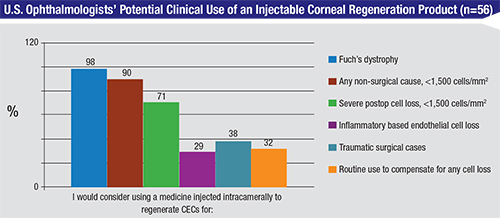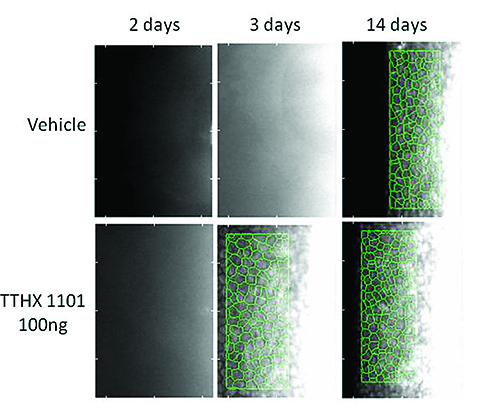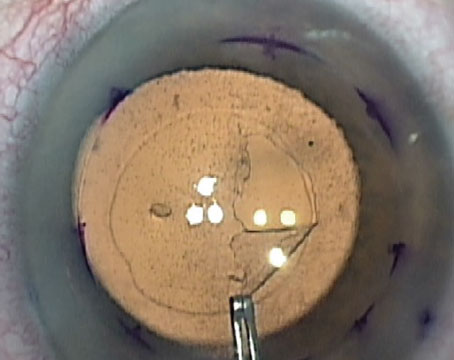Typically, a healthy cornea has about 3,000 endothelial cells/mm2 in the central area.1 CECs, or corneal endothelial cells, unfortunately, are lost with age. This natural reduction rarely presents a clinical problem unless the loss of cells is unusually aggressive, such as in Fuchs’ dystrophy, or there is excess cell loss that might occur with trauma, typically surgical.
As endothelial cell loss worsens, the remaining cells can typically spread and cover the exposed portions of the overlying cornea to maintain visual function. However, if the cell density decreases to about 400 cells/mm2 then insufficient cells may be available to effectively keep the cornea dry.2 Corneal edema then may occur, with associated visual loss. In addition, epithelial edema may occur, resulting in a painful, debilitating foreign body sensation. Unfortunately, CECs do not naturally regenerate. When lost, they are gone forever.
The only routine treatment available for edema resulting from endothelial cell loss is corneal transplantation. While this procedure may be effective in regaining some measure of sight and relieving pain the post-surgical follow-up process is long and difficult, with some patients not achieving their best vision for some time after transplant. Further, ultimate graft failure may occur necessitating re-grafting.
Survey data accumulated by Dr. William C. Stewart (internal data, PRN PharmaFarm, LLC) has noted that ophthalmologists perceive a need for a corneal regeneration product not just for Fuchs’ dystrophy, but also for endothelial cell loss associated with age and with surgical cell loss in complicated cases (See Table, next page).
To date, no pharmaceutical therapy has been approved by the Food and Drug Administration to treat this condition, either by preventing CEC loss or by regenerating the CECs to avoid transplant surgery. Fortunately, several ophthalmic start-up and mid-size companies have potential pharmaceutical therapies in development that when available could greatly help patients and change how corneal failure is treated.
 |
| (Click table to enlarge.) |
Engineered FGF–1 (Trefoil)
• Background. Engineered fibroblast growth factor (eFGF, Trefoil Therapeutics LLC, San Diego) is a biologic derivative of the FGF hormone that occurs naturally in the body. There are 22 different naturally occurring FGFs. They have been developed for prior indications by several different companies including:
• Kepivance (palifermin, FGF-7) is approved in the United States to treat mucositis (manufactured by Swedish Orphan Biovitrum AB, Stockholm, Sweden).
• The wild type FGF-1 was clinically tested in dermal wound healing by Merck.3
• Fiblast Spray (trafermin, FGF-2) is approved in Japan and China for wound healing and clinical trials are ongoing for indications in periodontis and bone fractures.
• FGF-2 has been clinically tested as an eye drop.4
Recently, Michael Blaber, PhD, working from his laboratory at Florida State University, engineered a series of new FGF-1s (eFGF-1) for the indication of both wound healing and corneal endothelial regeneration.
• Mechanism. FGF-1, also known as acidic FGF (aFGF), is a potent and broad-spectrum mitogenic, chemotactic and survival factor for a variety of cells that can promote repair and regeneration of damaged tissues. FGFs function by binding to high affinity transmembrane FGF receptors.
Engineered FGF-1 possesses the following potential clinical advantages:
• increased potency for stimulation of CEC proliferation;
• enhanced stability; and
• prolonged tissue binding, even to dystrophic tissue.
• Efficacy. In in vitro experiments using rabbit and human CECs, eFGF-1 stimulated proliferation with EC50’s up to 100-fold lower than unmodified (wild type) FGF-1. Preliminary studies have confirmed the ability of eFGF-1 to accelerate corneal endothelial regeneration in the cryogenic injury model in the rabbit (See Figure 1, p. 78).
Further research is ongoing to better quantitate the efficacy of eFGF-1 and to determine proper dosing levels (internal data, Trefoil Inc.).
• Adverse events. Hypothetical adverse events based on the pharmacology of eFGF-1 include angiogenesis and elevation of intraocular pressure due to proliferation within the trabecular meshwork. To date these effects have not been observed in any of the in vivo ocular dosing development programs.
Stem-Cell-Based Regeneration
• Background. JCR Pharmaceuticals Co. (Hyogo, Japan) has developed a novel platform based on human mesenchymal stem cells (MSCs) which has progressed to the clinical study phase for at least one indication. MSCs developed by JCR are produced from bone marrow aspirates collected from healthy donors. These cells may be administered to patients without donor-recipient human leukocyte antigen (internal data, JCR Pharmaceuticals).
• Safety. No safety issues have been noted to our knowledge directly from transplanting stem cells to regenerate CECs. However, generally, stem cells may possess features similar to cancer cells including: long duration; relative apoptosis resistance; and replicative capacity for extended periods of time. In addition, similar growth regulators and control mechanisms are involved in cancer and stem cell maintenance. Therefore, stem cells potentially may undergo malignant transformation which is often believed to be a key obstacle to their safe use.5
ROCK Inhibitors
• Background. A completely different therapeutic strategy from JRC is exemplified by a new study testing Rho-associated kinase inhibitors, or ROCK inhibitors, as stimulators of CECs.6 Although the mechanism has not been clearly established, this approach may inhibit endogenous pathways that limit CEC growth by altering cell adhesion and attenuating cell-contact growth inhibition.
In addition, apoptosis may play an important role in the pathological condition of corneal endothelium, such as in Fuchs’ dystrophy or post-keratoplasty. ROCK inhibitors might suppress CEC apoptosis caused by myosin light chain phosphorylation.
• Safety. Safety issues related to the use of ROCK inhibitors to regenerate CECs are unknown. From ongoing clinical trials with topical formulations for glaucoma the major adverse events of most, if not all, ROCK inhibitors are ocular hyperemia and inflammation. This effect most likely results because of their vasodilator activity. (Asada K, et al. IOVS 2002;55:ARVO E-Abstract 2052) (Kakutani K, et al. IOVS 2002;55:ARVO E-Abstract 2055) (Kusakabe A, et al. IOVS 2002;55:ARVO E-Abstract 2058)
Magnetic Cell Technologies
• Background. Emmetrope Ophthalmics Inc. (Key Biscayne, Fla.) has developed a method for identifying, isolating and/or enriching human CECs. This method comprises a positive selection process in which a cell population containing human CECs is selectively bound with either a positive or negative affinity reagent relative to cells other than human CECs (e.g., corneal keratocytes, etc.)7
• Efficacy. Initial data has shown positive efficacy results. Twenty-two rabbit corneas underwent central endothelial debridement. (Kunzevitzky NJ, et al. IOVS 2002;55:ARVO E-Abstract 2040) Eyes treated with human CEC recovered faster than controls (treated with balanced saline solution+). At 28 days, the thickness of human CEC-injected corneas was comparable to that of the intact contralateral eye while control corneas remained thicker. Histology with immunofluorescence showed clumps of donor cells re-populating the stripped endothelial regions. This pilot study revealed that injection of magnetic human CECs may be a safe therapy for the treatment of corneal endothelial dysfunction.
• Safety. No acute inflammatory response was observed in any of the treated corneas. Cancer is the prevailing safety issue associated with stem cells and this adverse event is described more in detail under JCR Pharmaceuticals, above.
Inflammation Modulators
A number of studies have demonstrated that classical antioxidants can mitigate CEC loss under conditions of stress, even in cells from Fuchs’ dystrophy subjects.
• Sulforaphane (unsponsored). Sulforaphane (SFN), a naturally occurring isothiocyanate found in cruciferous vegetables, has been shown to activate endogenous anti-oxidative protective pathways.
Interestingly, SFN acts on a specific pathway (the Nrf2) that is known to be down-regulated in Fuchs’ dystrophy. Treatment of ex vivo corneas from Fuchs’ dystrophy subjects with SFN prior to peroxide exposure normalized the antioxidant response, suggesting that this or similar compounds may be a potential treatment for prevention of CEC loss.
• Efficacy. A study published in 2013 examined the effects of SFN in Fuchs’ dystrophy. After pretreatment with SFN, oxidative stress was induced with tert-Butyl hydroperoxide (tBHP) in ex vivo Fuchs’ dystrophy specimens.8 Pretreatment with SFN decreased CEC apoptosis by 55 percent in the unstressed group and by 43 percent in tBHP-treated specimens. These results suggest that targeting Nrf2-ARE pathway may arrest degenerative cell loss seen in Fuchs’ dystrophy.8
RTA 408
Reata Pharmaceuticals Inc., (Irving, Texas) is developing several novel classes of drugs with transcriptional activity called antioxidant inflammation modulators (AIMs), which also activate the biological transcription factor Nrf2. This protein controls the body’s production of hundreds of antioxidative and cytoprotective molecules and is associated with protection against a broad range of diseases involving inflammation and oxidative stress (internal data, Reata Pharmaceuticals).
RTA 408 is a member of the synthetic oleanane triterpenoid class of compounds known to potently activate the cytoprotective transcription factor Nrf2. This factor is known to be down-regulated in Fuchs’ dystrophy. Reata’s product RTA 408 has been formulated into a sterile ophthalmic suspension and is being developed for prevention of corneal endothelial cell loss due to cataract surgery.
• Efficacy. In a series of preclinical studies, a topically applied suspension of RTA 408 was effective in inducing antioxidative gene expression in the corneal epithelium and endothelium as well as reducing markers of postoperative inflammation.9
Reata has initiated a Phase II clinical trial (GUARD) to evaluate the effects of RTA 408 ophthalmic suspension for the prevention of corneal endothelial cell loss in cataract surgery patients (NCT02128113).10 No results from this study are publicly available. The potential safety concerns regarding Nrf2 activation are unknown.
New pharmaceutical therapies for corneal degeneration promise to transform the routine treatment of corneal endothelial cell loss by providing treatment that could either block the degeneration of the endothelial cell or cause regeneration of the cellular layer. Such therapies have the potential to replace corneal transplantation as the treatment of choice for patients with endothelial cell dystrophy or dysfunction.
These therapies would provide better vision for patients by removing the need for corrections of astigmatism that follows surgery. These promising treatments are still early in development but include: engineered fibroblast growth factor; corneal stem cells; ROCK inhibitors; and antioxidant inflammation modulators.
Much research is still required to develop efficacy and safety data to satisfy the FDA regarding the commercialization of these products. In addition, final formulations need to be developed consistent with regulatory requirements. However, early indications are that these products hold much promise for helping an important segment of suffering ophthalmic patients. The goal of being able to maintain normal vision in this important group of corneal patients is coming closer. REVIEW
Dr. Stewart is CEO and medical director of PRN Pharmaceutical Research Network LLC, an international ophthalmic clinical study management and consulting firm, as well as PRN PharmaFarm LLC, which specializes in financing new ophthalmic start-up companies to assist towards product commercialization. Ms. Nelson is a research coordinator for both companies. Dr Eveleth is CEO of Trefoil Therapeutics, LLC.. Dr. Stewart is a consultant for Trefoil Therapeutics and Ms. Nelson has no financial interest. For information, visit prnorb.com or prnorb.blogspot.com, or contact Dr. Stewart at (843) 606-0776; e-mail: info@prnorb.com.
1. Zavala J, López Jaime GR, Rodríguez Barrientos CA, Valdez-Garcia J. Corneal endothelium: Developmental strategies for regeneration. Eye (Lond). 2013 May;27(5):579-88.
2. Joyce NC. Proliferative capacity of corneal endothelial cells. Exp Eye Res 2012;95(1):16–23.
3. Mellin TN, Cashen DE, Ronan JJ, Murphy BS, DiSalvo J, Thomas KA. Acidic fibroblast growth factor accelerates dermal wound healing in diabetic mice. J Invest Dermatol 1995 May;104(5):850-5.
4. Meduri A, Scorolli L, Scalinci SZ, Grenga PL, Lupo S, Rechichi M, Meduri E. Effect of the combination of basic fibroblast growth factor and cysteine on corneal epithelial healing after photorefractive keratectomy in patients affected by myopia. Indian J Ophthalmol 2014 Apr;62(4):424-8.
5. Wang Y, Han ZB, Song YP, Han ZC. Safety of mesenchymal stem cells for clinical application. Stem Cells Int 2012;2012:652034.
6. Koizumi N, Okumura N, Ueno M, Kinoshita S. New therapeutic modality for corneal endothelial disease using rho-associated kinase inhibitor eye drops. Cornea 2014;33:S25-S31.
7. http://www.google.com/patents/WO2014179716A3?cl=en
8. Ziaei A, Schmedt T, Chen Y, Jurkunas UV. Sulforaphane decreases endothelial cell apoptosis in Fuchs’ endothelial corneal dystrophy: A novel treatment. Invest Ophthalmol Vis Sci 2013;54:10:6724-34.
9. Reisman SA, Lee CY, Meyer CJ, Proksch JW, Sonis ST, Ward KW. Topical application of the synthetic triterpenoid RTA 408 protects mice from radiation-induced dermatitis. Radiat Res 2014;181:5:512-20.1.
10. https://clinicaltrials.gov/ct2/results?term=NCT02128113.






